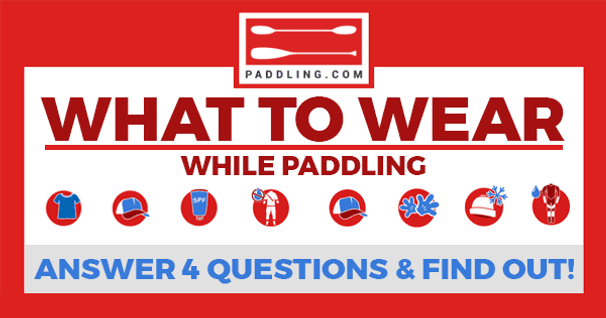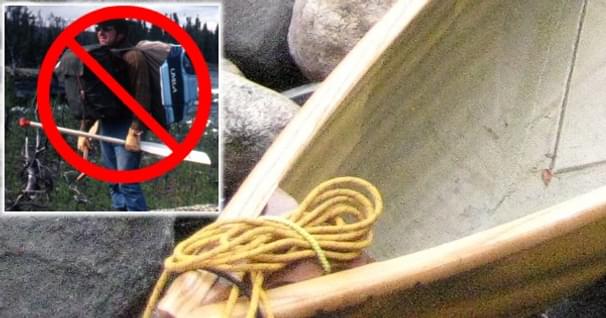The Pain of Portaging
"Anyone who tells you portaging is fun is either a liar or crazy." Bill Mason - Waterwalker
Let's face it. Portaging really hurts. Whether you are carrying over from one lake to another, or avoiding a set of nasty rapids, each trail has some painful characteristic: slippery rocks, steep inclines, bug-infested hollows, boot-sucking mud, and wrong turns. And there's always that particular canoe-mate who never seems to take their share of the load. So why do it? Well, it's one of those necessary evils that come with canoe tripping. That brief moment of pain is the only thing standing in your way of absolute solitude. In the end, the moment you spot that spot of blue peaking through the thick canopy of green, and then realize you're alone in this wonderful place, it all becomes worth the price.
Ways to relieve the pain of portaging:
- Make sure there are no loose items dangling from the packs. Everything should be stuffed inside a large volume canoe pack.
- When choosing your pack look for a hip belt, chest strap, and a tumpline to lessen the sagging feeling a heavy pack can give; it's especially helpful while going uphill.
- Place a folded sleeping pad inside the back of the pack to avoid jagged objects from poking into you.
- Practice carrying your packs around the block before attempting to drag them across a portage. If you're having problems, unpack and start taking out items you can do without.
- Avoid single carries when possible. Portaging twice across obviously takes longer. But injuries are less likely to happen en route and you'll be able to pack along a few luxury items.
- Try the "trip and a half. " It's when both canoeists head across the portage, one with a pack and the other the canoe. Halfway along the one carrying the canoe stops, puts their load down, and then returns for the second pack. The person carrying the first pack continues on to the end, and then returns for the canoe. If only one person in the group is able to carry the canoe, then just alter it so you both start off with packs, and one person goes back for the canoe. Either way, you are only walking the portage one-and-a-half times rather than three.
- Strap fishing rods along the inside gunwale of the canoe with bungee cords and make sure no lures are attached. There's nothing worse than having fishing line getting tangled up in brush or having a fish hook stuck in gear, or worse, yourself.
- Strap the extra paddle along the gunwale with bungee cords.
- Assign each person in your group the equipment they are responsible for carrying across. This helps organize everything at the take-out and put-in, as well as places responsibility on each individual, in case there's something missing at the end of the day.
~Get the BWCAW Tee~
With over 1,090,000 acres of wilderness area, the BWCAW is a paddler's paradise.
- Splurge on either renting or buying a light weight canoe. It's worth it.
- Learn how to single carry rather than shoulder the canoe with your partner. It's actually easier in the long run and fewer arguments will erupt (see portaging technique below).
- Most canoes are factory built now and generally come with a cheap yoke which is placed smack dab in the center, creating poor balance. Having a custom made yoke that conforms to your own shoulders is your best bet. Then, you want to place the yoke on the canoe yourself. Try to place it back a bit from center, making the canoe slightly tail heavy.
- A tump strap can help spread the stress of the load and stops the canoe from slipping down your back. Take note, however, that a tump may not be for everyone. By resting the weight directly on the spine, neck muscles are essential.
- Try to occasionally drop one arm to your side, gripping the other side of the gunwale with the other arm, making sure it's outstretched and your elbow is straight. Then switch. This technique transfers the weight from one shoulder to the next and gives you a few extra minutes of pain relief.
- Avoid getting cramped hands by not holding the gunwales all-together. Instead, place a carrying bar in front of you, just within reach. This, of course, reduces the area for packs or a third paddler, so you may want to just simply tie a rope from the bow and grasp on that to keep the canoe properly balanced.
- Pace yourself. It takes, on average, twenty minutes to portage 1000 meters (2000 yards). When carrying packs one can generally suffer for at least forty minutes before having to stop and rest. But with the canoe you usually have to stop every twenty minutes and rest for five before continuing on.
- While on a trip with long portages, pack along a big bag of treats. At the end of each carry, celebrate by gorging yourself on candies or chocolate. It's amazing how the thought of having something sweet at the end of the carry may be the only thing that will push you to get the job done.
- Singing on the portage helps the time pass quicker. Just make darn sure that the last song you heard on the radio before embarking on your trip was a good one. For some reason, it's usually the tune that's in your head for the entire trip.
Playing the Part of Mr. Canoe Head
To some, it's much easier to load themselves up with heavy packs and stumble across the portage than it is to balance a canoe over their heads. But I much prefer to choose the canoe. I'm not all that muscle bound and depend much more on technique rather than brawn. This is why the canoe is much easier for me to handle. Portaging, and most important, lifting a canoe over your head is all about technique, not strength.
To properly lift the canoe up over your head, follow these steps:
- Start off by standing amid ship, grasping the gunwale with both hands and titling the canoe so the hull is pressed against your legs.
- Then, by grabbing the center of the yoke with your right hand, hoist the canoe up to your thighs. With the canoe resting on your thighs, reach over and grab for the far gunwale with your left hand, just forward of the yoke.
- The next part is the most important but also the most difficult. Begin swinging the canoe gently back and forth on your thighs like a pendulum. Then, with one solid motion, flip the canoe over your head, with the yoke landing on your shoulders. Don't worry. Your head and shoulder will magically locate the yoke on their own. Just make sure not to hesitate. The weight of the canoe will be lighter the faster you flip. Remember: "Right-left-right-flip" and you'll be fine.
- At the trail's end, place the canoe "gently" down by using the opposite procedure, making sure to lower the canoe onto your thighs first to avoid smashing the hull against a rock.
 Definition
Definition
The word "portage" is French for "to carry."
Portages are measured in meters, yards or rods.
1 meter = 1.0936 yards 1000 meters = 1 kilometer = 0.6215 miles 1 yard = 3 feet 1760 yards = 1 mile 1 Rod = 16.5 feet or 5.5 yards (approximately one canoe length) 320 Rods per mile (5280 feet)
And you thought you had it bad...
While traveling the historic Grand Portage, Alexander Mackenzie noted in his journal that voyageurs would head off on the 17 mile (30 km) trail with two packages of ninety pounds each, and return with two more of the same weight in under six hours
Two Heads are better than One
If you feel too uneasy about lifting the canoe over your head on your own, then do what's called a two person lift, followed by a one person carry. Have your canoe partner stand beside the canoe near the bow and position yourself an arms length away, somewhere between the front seat and the yoke. Then, both of you grab the opposite gunwale with your left hand and the other gunwale with your right. Flip the canoe over your heads, making sure the back end of the canoe doesn't leave the ground. Now, while your partner holds the canoe up, you slide backwards and position yourself under the yoke. Once you have control of the canoe then your partner lets go and meets you at the end of the trail to help you unload, using the opposite procedure.
The same technique can be used on your own. Just flip the canoe over at the front of the canoe without the aid of your partner. As long as the back end of the canoe keeps touching the ground you are not carrying the full weight until you slide yourself under the yoke.
Also, it is possible to have both paddlers carry the canoe together, even though there's a real danger of you and your partner not speaking to one another by the end of the portage. To keep the arguments to a minimum, make sure not to have the person in the front stick their head up inside the bow. Portaging then quickly becomes a game of Blind Man's Bluff. It's best to have them place the bow plate on one shoulder, enabling them to see where they're going, and then position the other person under the stern thwart or back seat.
Record Breaking Portage
The record for carrying across Algonquin's Dickson/Bonfield Portage (measuring 5,305 meters or 5,802 yards) is 41 minutes, set by Bill Swift Sr. while carrying a canvas-covered canoe and loaded pack.
Portage Etiquette
 It was the day I got hit in the crotch with a paddle by a not-so-polite canoeist on a busy portage that forced me to come to the conclusion that no portage etiquette seems exists anymore. I was carrying a hefty 18-foot canoe down the path leading to Algonquin's North Tea Lake. She was carrying a paddle - just a paddle - yet she refused to give the right-of-way. We played chicken and I lost. When I reached the put-in I immediately pulled out my journal, wrote a list of rules for proper portage etiquette on a sheet of paper, and then stuck it on a tree for the next bad-mannered canoeist. This is what it read:
It was the day I got hit in the crotch with a paddle by a not-so-polite canoeist on a busy portage that forced me to come to the conclusion that no portage etiquette seems exists anymore. I was carrying a hefty 18-foot canoe down the path leading to Algonquin's North Tea Lake. She was carrying a paddle - just a paddle - yet she refused to give the right-of-way. We played chicken and I lost. When I reached the put-in I immediately pulled out my journal, wrote a list of rules for proper portage etiquette on a sheet of paper, and then stuck it on a tree for the next bad-mannered canoeist. This is what it read:
- When meeting someone coming the other way on the portage the person carrying the canoe should always be given the right of way.
- All packs and canoes should be stored to the sides of the put-in and take-out areas. This prevents a traffic jam for others wanting to use the trail,
- If you're holding up others walking behind you, take a second to move off the trail and let them pass.
- If you have to relieve yourself, do it well off the trail, at least 100 meters from the water source and any blueberry patch found at the put-in or take-out.
- Always double check the put-in and take-out areas for any garbage or forgotten piece of gear.
- Place any lost piece of gear found along the trail in plain view at either the take-out or put-in.
- Remember to say hello and give a smile to your fellow canoeists when passing them by.
Kevin Callan is the author of eight books including 'The Happy Camper: An Essential Guide to Life Outdoors'. He is a recipient of the National Magazine Award and a regularly featured speaker at North America's largest paddling events.
Related Articles
Wondering what to wear when going paddling? Answer 4 quick questions and instantly learn what you need…
In 1971, I outfitted and guided three wealthy Chicago men--the least affluent of which earned a quarter…
Christmas is just around the corner and you are again left wondering what to offer your favorite…
In the mid-seventies, I shared an afternoon with the famous woodsman, Calvin Rutstrum, whose flagship…




